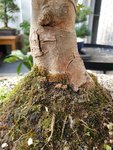BalconyBonsai
Yamadori
Hi, I have noticed that my trident maple have a white powder-like substance around the edges of many of it's leaves. I'm trying to understand what it is and if I need to deal with it. The closest I have found is powdery mildew but from looking at pictures online it still doesn't look very similar. The powder on my tree pretty much only sticks to the edges of the leaves and doesn't form any spots. If I rub it with my finger nail it is removed. There is some similar stuff at the base of the trunk and it is most visible when not wet. The tree is not sheltered to the wind and is facing south with no protection against the sun.
Appart from this the tree seems healthy to me and new shoots are popping up all over the tree and it looks normal I think. I have seen similar stuff on my deshojo that sits just beside it but on that it very sparse.
Do you think I need to do anything about this? I think leaves will drop in at most a couple of months but I don't want something to hibernate and then "attack" the tree just as it wakes up.
Appart from this the tree seems healthy to me and new shoots are popping up all over the tree and it looks normal I think. I have seen similar stuff on my deshojo that sits just beside it but on that it very sparse.
Do you think I need to do anything about this? I think leaves will drop in at most a couple of months but I don't want something to hibernate and then "attack" the tree just as it wakes up.





